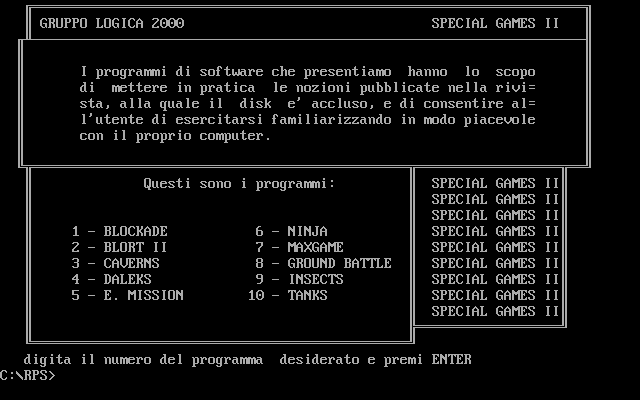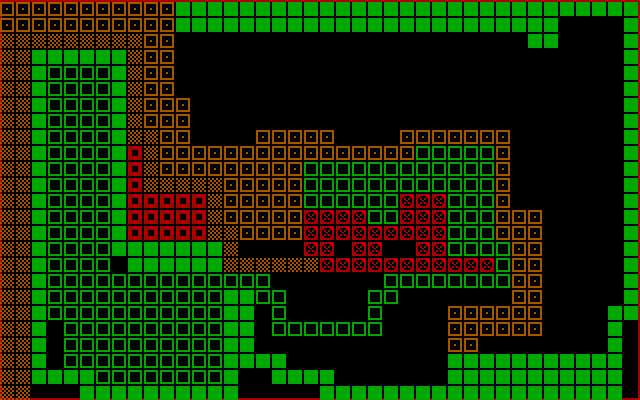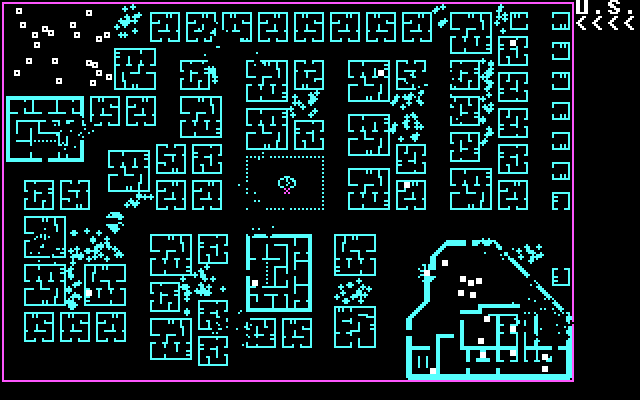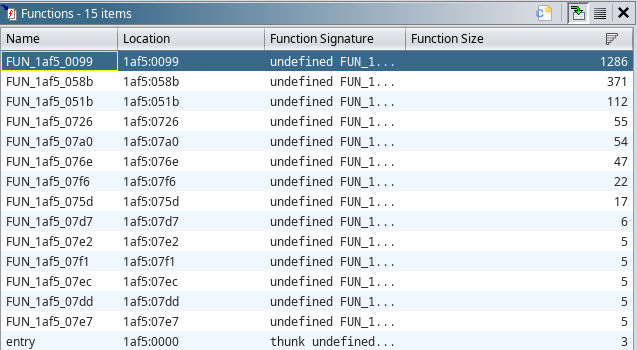
Alberto Marnetto's Notebook
Note: If you only want to download the lost game, jump HERE.
For this post I will remove my engineer hat and be a game historian for a day. I will present the content of one of the first game disks I ever played. I always called them the “RPS games”, as the floppy containing them was engraved with the eye-catching logo of the Rhône-Poulenc Systèmes. It contains rarely seen oddities: most of the games have a single-digit number of YouTube videos and one of them has never appeared on the Internet: for what I know I might be owning its last surviving copy.
Some historical context first: the floppy was an attachment to an Italian magazine produced by the publisher Logica 2000. Italy has a tradition of games published this way: selling copies at newspaper stands was a way for low-budget productions to reach a wide audience at reduced cost, and releasing the game as “attachment” to a paper publication allowed them to enjoy the reduced VAT for editorial products. Perhaps one of the last and most prestigious examples of this system was PC Calcio 6, Italian version of PC Fútbol 6 by Dinamic Multimedia, which was formally just the supplement of a dummy publication called “Yearbook of Italian football”. Many players would buy the game and throw the paper in the waste bin as soon as they got home.
This distribution method would per se be alright; unfortunately, however, some of the companies involved were not in the business of making games; instead, they stole them. They would find software products in the international markets, pirate them, erase the authors’ names – sometime even the original title – and market them as their own, usually packing many of them in cheap bundles. Incredibly, the practice was borderline legal: until 1991 the Italian law did not extend to computer programs the copyright protections it afforded to books and music, so that any piece of software was, in practice, public domain. I cannot quantify how damaging this situation was for the aspiring software developers in the country, but the fact that the 20th century features no internationally relevant Italian video games – compared to the interesting productions of similar countries like France and Germany – is in my opinion also a consequence of a situation where there was no incentive to be creative: steal someone else’s sweat of the brow, or someone will steal yours.

The collection I’m going to review is the result of one of these acts of lawful piracy. This specimen is less dishonest than others, since the robbers at least left the original authors’ names, but they erased any request to send money to support them and inserted the Italian publisher’s name. For this reason I am not going to offer the games for download here: I’ll be happy to see the pirated copies vanish into oblivion. For the most worthy games I will provide a link to their original version: I will preferably link to DOSGames.com, since that site takes great care to only publish redistributable titles (shareware, demos, open source, etc.).
As an exception, I will offer for download Insects, the “lost game”: I think it is necessary to share it to prevent it from disappearing completely. Should its original author contact me I will be happy to comply with their wishes with respect to the game’s distribution.
Before we start, some general considerations:
My rating: 🙂
The collection starts on a strong note: Blockade is probably the best game of the bundle. It’s a port of the 1976 same-named arcade game, which has you control a snake leaving a trail, trying not to collide with either yours or your enemies’ trails. The strategic idea is to wall in your opponents so that they are forced to consume the free space faster than you do.
The concept is simple but this edition implements it really well. It offers up to 5 computer opponents with a competent AI offering a good level of challenge, and it features an option to control whether the trails of the eliminated opponents progressively vanish or stay on the screen forever. Both modes are worth playing: the first one leads to tense situations where you are trapped by the body of a dead enemy and hope it disappears before you are forced to crash into it, the second produces very pleasant abstract patterns, a rare case where the limited palette (green/red/brown) produces aesthetically valid results.
A Blockade game is composed of various rounds. The pace is rapid, with each round lasting from a few seconds to about a minute and the whole game typically being decided in about 15 rounds with a Formula 1-esque system being used for the scoring. The controls are very responsive and the detailed instruction system shows how much care went into polishing the players’ experience. The game auto-adjusts its speed according to the machine clock, a nice touch considering the era.
Playing Blockade today is still enjoyable and I think it’s not a coincidence if, of all authors of the games in this bundle, Mr. Laabs is the one who went on to have the most remarkable career in the video game field. His MobyGames page sees him covering the roles of VP at Mindscape and Senior Producer at Electronic Arts. I contacted him some years ago, half-jokingly asking him if I could register a copy of Blockade: he did not take my offer seriously but was glad that even his earliest creation was still remembered. He reminded me one can get the game on most abandonware sites, and I’m happy to suggest you to grab a copy at DOSGames.com.

My rating: 🙁
From hero to zero: the second game of the bundle is in my opinion the worst, albeit with a twist. Maybe we can start with the gameplay video.
So, that’s it. A monochrome game that has you trying to shoot an alien, both of you uncontrollably moving left and right. Your rate of fire is limited by the fact that there can only be one missile on the screen. There is no realistic way to aim, so you just spam the fire button till you randomly hit your victim. On level 2, a landmine occasionally appears on the center of the baseline, so you also mash the arrow key to push your vessel away and avoid being destroyed. This is also the only way to lose a life: the game ends when your finger muscles cannot press the key fast enough, or when you realize the pointlessness of all this and surrender to your fate. During the whole process the other ship does not try to hurt you in any way; the backstory reveals that your colleague has accidentally destroyed an alien and you are trying to eliminate the witnesses. We are, indeed, the baddies.
These would be enough words for this game, but as I was researching for this post I came across an article that frames the story from another point of view. The game’s author, John Rudzinski, published an article “IBM High Resolution Animation” in Electronics Today, June 1987 issue, explaining how to create smooth animations on the IBM PC using advanced assembly techniques. At the end of the article, Rudzinski cites Blort II as “a game I wrote using the above principles”. So this is why gameplay and backstory are so awful: it is a technological demo, not an entertainment product! The best way to enjoy it is not to play, but to read its source code, maybe in printed form, and try to reconstruct its working principles. While this does not change my final judgment on the game, it greatly mellows my feeling towards Mr. Rudzinski, who was also kind enough to put his creation in the public domain.
You can find Blort II in various abandonware sites. But, really, it’s not worth your time.
My rating: 🙁
For some reason, playing this game feels like a chore. The rules are very simple: guide your man to step on all the pixels of this underground cave, avoiding the green poisoned arrows. However, there are too many platforms, or too few other things to do, for me to have the patience to finish the level. Apparently there are four stages, and if you complete all of them you have to correctly answer three trivia questions to win. I could find no YouTube video going even just as far as the second level – which I managed to see once, only to lose immediately after.
For all its faults, Caverns of Gink must have had some admirers, since around year 2016 someone set up a small site dedicated to it, with even some plan to develop a sequel. You can visit the archived copy. As for me, the game is forgettable. I think it was released as freeware, but really, go discover a modern indie game instead.
My rating: 🙂
For this game, instead, simplicity works. Daleks is a Doctor Who-themed clone of Chase, a turn-based game where you move your character on a grid while a number of computer-controlled enemies try to catch you. Both you and your enemies move like the King in chess. The arena has no escape and you are just one against many, so you must rely on three mechanisms to survive:
If you clear a level, a new stage appears with more enemies. You are doomed to die eventually, so the goal is to destroy as many daleks as possible.
Daleks, after learning the basic techniques, is mostly luck-based. If you avoid errors you die when you are forced to teleport and the RNG decides you land near a dalek. You can learn some advanced tricks to save yourself a jump or two, but that’s all. When I was a kid I hoped there was more to it: if you decide to pass your turn, the character finds various inventory objects in his pockets and I hoped they had a use. Maybe that Tibetan book about mountaneering can be used to climb the piles of destroyed daleks? But no, the game is true to its minimalist nature, and the “you find…” messages are just ornament.
Daleks was one of my favourite time-wasters for a long time. I intermittently played it in many phases of my life, occasionally setting a new record in my lifetime high-score table – naming some of the entries with references to my mood and life situation at the time. Progressively the laws of the Poisson distribution made new records rarer and rarer, and eventually I found new ways to relieve stress.
You can get Daleks on the Internet Archive (link, click on DALEKS.EXE). It’s formally a shareware game, and I’d be happy to pay the $5 requested for the registration, but the author seems nowhere to be found.
My rating: 😐
This is the classic game where the whole is more than the sum of its components. As in: there are two parts and both are worthless, but somehow their combination holds a certain novelty value.
In the first half of the game you must take down incoming space ships, in a sort of hyperaccelerated Space Invaders. The manual (not included in this pirated version) suggests you avoid medical ships and shoot at the aliens instead, but good luck discriminating your targets when they are coming at you at such speed! In the video I have made the game slower than it was in my 286, and still the rhythm is frantic.
If you manage to shoot down 50 enemies before the time is over, you switch to the second part, a mathematical-logic game where you must find a cure for the humans injured by enemy “Bio-Bombs” before you run out of available serum (or research subjects!). Your performance in the shooting phase affects how many resources you have available. If you take too much time to cure a patient, he will die with a combination of graphic and music that appears silly today, but genuinely frightened me as a kid.
The whole product would be good were it not that it can be beaten so easily:
Despite its limits, Emergency Mission manages to deliver some thrill. Its replay value is very low, but I enjoyed the five-minute session I took to record the video. Sometimes a soup with mismatched ingredients can still turn out tasty.
Emergency Mission was distributed as shareware, and it’s available on DOSGames.com.
My rating: 😐
Ninja is a basic combat game. You lead your martial arts warrior in a dungeon filled with enemies. You attack the opponents with an undescribed hand technique and they do likewise with you. Additionally you can jump and crouch. Any time you defeat an opponent, a new hole opens in one of the level floors. After enough attempts, the pierced floor will be the bottom one, allowing you to jump into it and proceed to the next level. At each stage the number of enemies increases by one and they become faster. Additionally, starting from level 6 the dreaded red ninjas appear, which are much stronger and tougher than the regular variant.
The best way to survive is to avoid being surrounded and learn the correct attack rhythm. Keeping the fire button pressed will result in a brief burst of attacks, but your character will soon get tired, being transformed into a “downed” icon and rendered harmless for a while. Much better is to press fire at a rate of 5/6 hertz, which your warrior seems to be able to sustain indefinitely. There is no health or energy bar on the minimalistic screen, so you need to assess your status by gut feeling.
The game is, for all I know, endless; getting to see the red ninjas is a reasonable goal you can set for yourself. As you can see in the video, however, the pace of the game is somewhat slow for modern standards. If you stay on the higher platforms you eventually run out of opponents, and if you move onto the lower ones you risk being overwhelmed by your enemies. Ideally you want to linger on an intermediate floor and hope that the Brownian motion of the adversaries brings you in contact with exactly one of them. Moreover, you are suggested to crouch and stay against a wall to minimize your vulnerable surface.
In some moments, e.g. at 8:05 in the video, I tried to make the enemy ninjas gather together in a floor below me, hoping they would wound each other. On these occasions the game produces its attack sounds but nothing seems to happen. I think there is not enough in this game to deserve a deeper analysis. Still, as a kid I found it somewhat entertaining.
Ninja was distributed as shareware, and it’s available on DOSGames.com.
My rating: 🙁
Maxgame is a variation on Snake. The game features a couple of space-themed elements, namely the arena contains spiral-shaped obstacles resembling galaxies and there is a teleport feature. Both these novelties worsen the playing experience: the galaxies make it basically impossible to reach the next target if it happens to spawn inside one of the spirals, and the hyperspace adds a chance element to a game that should be mostly about the player’s skill. For some reason, the Italian magazine ignored the sci-fi hints and said that the player is supposed to be a swimmer, careful to avoid dangerous water vortexes.
(Aside) I must have read that magazine for the last time 35 years ago. Since then I have seen and forgotten millions of words, places, faces, stories, voices, songs, promises, names and assorted concepts. If our memory works like a set-associative cache, how many useful things have been discarded so that this worthless piece of trivia could stay in my brain indisturbed? Why are we humans so imperfect? Aaargh! Maybe by writing this information down my mind will finally be convinced to let go of it.
…where was I? Ah yes, the last unpleasant details: it is even unclear why you should try to hit the targets, since you score points merely by moving; there seems to be no level change (if there is, I never managed to attain it), and your trail does not disappear, making you doomed to crash from the start. You can choose the screen hue, but if you don’t know the palette color codes there is a high chance you’ll get a horrible and/or unplayable result. By the way, “palette” can also mean “toy spades” in Italian: as a kid I always hoped that the swimmer could eventually reach a beach and build himself a sand castle. Alas, it never happened.
Maxgame was released as shareware. Before asking if you could get that, ask yourself if you should.
My rating: 🙁
A game of tactical combat set during the Second World War? Perfect, we can delegate this to Narwhal, the Wargaming Scribe…
Well, actually we cannot. First, because it’s a multiplayer game, so it’s out of his scope. Second, because I like his blog very much and I don’t want to add further misery to the pile of mediocre titles he reviews.
Battle Ground sees you lead a squad of soldiers in an undescribed skirmish between U.S. and German forces. In practice you spend most of the time dragging your cursor around to select each member of your team. After reaching one, you have some seconds of enjoyment as you check your soldier’s status, decide his action for the turn (move, shoot, throw grenade, plus some special actions depending on situation and role) and watch a handful of pixels move depicting the result of your choice. Then you resume your cursor’s pilgrimage, heading for the next grunt.
The game has no computer A.I., so after finishing your turn you should pass the control to a friend to command the opposite army. But it’s pretty obvious that if you are playing this game, and you are even crazy enough to complete a turn, you most probably have no friends to speak of!
Now, let me be clear: I know that wargames require patience and dedication. But the effort should be due to a game’s complex mechanics, not to the frustration of an unwieldy user interface. The only strong point of the IBM PC is its keyboard; it would have been easy to let you select each soldier through a hotkey and choose the action via a mnemonic letter. Instead everything is limited to the numpad, with some extra contortions on top, e.g. key “2” moves the cursor down as it should, but when choosing the firing direction it indicates to shoot up and to the right.
I wish I could give at least a neutral rating to this game, because it was made with some passion and it taught me the cool word “bazooka”. Reddit shows it had at least one admirer. But the absence of a single-player mode and a UI that does everything wrong are really too bad factors. As a consolation prize, I attach a further screenshot demonstrating the diversity of environments you can fight in.

Dave Snider (or Snyder)’s company, MVP Software, had a moderate success as publisher of shareware titles. Its still existing webpage says it was active as late as 2014. Unfortunately, the site does not contain any contact information, nor are the game authors reachable elsewhere. You can still get the game at DOSGames.com.
My rating: 🙂
We finally arrived to the important part of this article, the unearthing of a lost piece of video game archaeology. Ladies and gentlemen, here’s to you Insects!
Insects is a maze arcade similar to Pacman or Serpentine. You must maneuver your (cat-like?) character in the field, avoiding a pair of insects wandering through the screen. If an insect catches you, you lose a life. The same happens if you run out of time; whenever you respawn the timer is reset to the starting time. The enemies are ladybugs at level 1, spiders at 2, centipedes at 3 and bees at 4. If stage 4 is cleared, the cycle starts again with ladybugs at level 5, spiders at 6 etc. At every stage the enemies get a little faster.
Blue buds occasionally appear in the maze; to clear the stage you must collect enough of them before the timer runs out. You do so by firing your eyes (?) to the buds, making them bloom and able to be collected. At each stage you must pick up an increasing number of buds (4 times the level number, capped at 32), but you also get more time.
Firing onto an approaching enemy is useless, but if you hit it in the back it will start blinking, drop four extra buds and eventually die and respawn. This is especially useful to fill the bud quota in time on the higher levels.
Both collecting buds and successfully shooting an enemy add to your score. Additional points can be obtained by collecting a special bonus item (a blinking dollar symbol) that occasionally appears. Your final points are printed at the end of the game, but there is no scoreboard.
An interesting feature of the game are the red rotating doors. You can push them, but your enemy cannot, creating interesting gameplay mechanisms. On some levels you can enclose the insects in a confined area and roam through the rest of the stage undisturbed, on others you can devise reliable methods to consistently dodge an enemy catching you, then reappear at its back and shoot it, in a sort of corrida. As pointed out by the commenter “sagacity” (thanks!), this mechanic seems to have been taken from the arcade game Lady Bug or its C64 derivation Lady Tut.
Insects is one of the best pieces of the collection, one of the few that still occasionally entices me to play one game or two. I like how the concept takes a familiar genre and adds a couple of interesting features. The esthetics are good despite the limits of the CGA graphics: the insect shapes are instantly recognizable, and the protagonist’s appearance is very original. The pace and duration of a game are in my opinion perfect for a casual player. If I must point out defects, the reaction to keyboard inputs is not always prompt and the number and quality of the levels could be improved.
It is a real pity that the only game of the collection where the name of the author is absent is also the only game not documented anywhere else. I don’t know why the creator’s name is missing while in the other bundled titles it was left in. Maybe it was hacked by a different person than those adapting the others, maybe it was distributed as anonymous creation from the start. A third hypothesis is that the program was not stolen, but sent to the magazine publisher by one of its readers. Even magazines publishing pirated software used to invite their fans to send them their creations: for these programs (unlike what happened for stolen titles) the author was properly credited and rewarded with a good amount of money. Unfortunately, my copy of “Special Games” is long gone, and the Internet has no information about this publication. Anyway, given the high quality of Insects the likelihood of it being a mail-in game is low – readers’ contributions were usually of much lower quality than pirated games.
In the hope of finding out more about the game I processed it with strings, then with Ghidra. A string INSECTS.BAS in the executable reveals that the game is the compiled version of a Basic listing. The decompiler says that most of the instructions are in a unique big function:

'0099 is the protagonist here. Its rival function '058b is a file-opening algorithm (probably part of the compiler runtime), the others are very small.I wanted to write “function '0099 contains the game code” and be done with it. However, neither ChatGPT nor Grok are convinced of that, and I’m missing time to analyze it properly. Grok says the function tries to load two resources, the first of which should be the real main executable, but there is no other “main executable” to speak of. I suspect that the first loaded file is BRUN30.EXE, the QuickBASIC runtime, whose filename is not found by Ghidra but is present in the binary… A good analysis would take days and it’s out of scope for this article – maybe a future project.
Other findings: the game contains various data strings, in a notation that makes me think of the Logo language or the PLAY command in Basic:
DCc2 r1 u1 nl1 c1 nm+1,-1 bd1 nm+1,+1
lCc2bl3 u2 d3 bl2 u3 bl2 bd1 d1 bl2 u1 bu2 c3 m+2,-5 r3
Cm+2,+5 bd5 m-2,+5 l3 m-2,-5
Cc2bl3 u2 d3 bl2 u3 bl2 bd1 d1 bl2 u1 bu2 c3 m+2,-2 r3
JGta 90 c3bm 98,98 nm-7,-6 br2 nm+2,-7 c2bm+4,+2 r1 d1 l1
Gta 270 c3bm 98,98 nm-7,-6 br2 nm+2,-7 c2bm+4,+2 r1 d1 l1
All ta commands are followed by multiples of 90, which seems to lend more credence to the first hypothesis (ta = “turn angle”?), but I could not find any Logo variant with this syntax. Did the author create his own drawing system?
A final word for the two data files provided with the program. They contain a list of numbers, which can be decoded as quads describing segments (x1, y1)–(x2, y2). Maybe the executable contains the shapes of the animated characters, and the data files the static geometries?

To play Insects, follow these steps:
insects)BRUN30.EXE, e.g. from this page (CTRL+F for the name of the file).1Note: I have erased the name “Gruppo Logica 2000” from the executable since I see no reason to honor the memory of the group. I have also made a couple of further small, non-functional modifications as watermark: if someone claims to have owned or authored the original version they can prove that by telling me what I have changed.
My rating: 😐
Tank Wars is an artillery game. It has not the fanciness of later titles like GORILLA.BAS, Scorched Earth or Worms, but does its job well for its time. Out of the games in this bundle it is probably the most famous one: it has a citation in Wikipedia as the first artillery game for MS-DOS and its own MobyGames page. It’s a pity that Mr. Snider never released a sequel (the same-named game series started in 1990 by Kenneth Morse is unrelated) nor other titles.
Differently from most games in this genre, Tank Wars is played in real time. Quick fingers are a necessity as you move your tank left and right, activate your defensive shield or execute a well-timed jump to dodge an incoming projectile. In the middle of doing that you must aim your cannon with the classical angle and power inputs. You can only shoot one shell after the previous one has landed, so jamming the fire button does not help.
A handful of extra features avoid the game being too basic. There is a hot air balloon which drops a bomb when hit and an indestructible bird which blocks your projectile. The terrain never collapses, allowing to dig galleries in the mountain between the opponents by repeatedly shooting into its side. The tanks have a limited quantity of fuel, which is consumed whenever they move or activate their shield. The wind speed is always changing, altering the missiles’ trajectories even if the player keeps their shooting parameters unchanged.
The game does almost perfectly what it sets out to do. Unfortunately it has a big problem that affects my rating: it does not adjust to the processor clock and, as a result, I was unable to play against the CPU since it was inhumanely fast even at “slow” speed. The issue is however less damning than in other titles, since Tank Wars is best enjoyed in two-player mode: I remember having a lot of fun playing against my father or my brother.
Thus ends our small journey in the prehistory of IBM PC gaming. Despite their limits, these small games managed to fill some rainy afternoons and started to get me interested into computers. I know it’s a long shot, but if anyone has more information about these creations and their authors, I’ll be glad to hear from them. I’d be especially interested in any kind of information about Insects, even just to know where else the game was published.
I cannot host BRUN30.EXE on this site for licensing reasons, but since it’s the redistributable part of MS QuickBASIC it’s a piece of software that other developers of ancient programs were legally authorized to provide. The link brings you to an old-style course page of Université Laval. ↩